The Thin Morning Moon’s Visit With Pretty Planets Lets Leo Lead Us to Spring Galaxies in Evening!

This terrific Wikipedia image by Hunter Wilson from March 28, 2008 shows the Leo Triplet of Galaxies, which is located south-southeast of the bright star Chertan in Leo. The photograph, with celestial north up and East toward left, covers 0.6 degrees of the sky left-to-right. The Hamburger Galaxy is at the top – do you see the patty and the bun? The distorted spiral galaxy M66 is at lower left, and edge-on M65 is at lower right. Hunter’s gallery of wonderful images is available at https://hwilson.zenfolio.com/galaxies
Hello, Galaxy Lovers!
Here are your Astronomy Skylights for the week of March 27th, 2022 by Chris Vaughan. Feel free to pass this along to your friends and send me your comments, questions, and suggested topics. You can also follow me on Twitter as @astrogeoguy! Unless otherwise noted, all times are expressed in Eastern Time. To subscribe to these emails please click this MailChimp link.
If you’d like me to bring my Digital Starlab portable inflatable planetarium to your school or other daytime or evening event, or deliver a session online, contact me through AstroGeo.ca, and we’ll tour the Universe, or the Earth’s interior, together! My terrific new book with John A. Read entitled 110 Things to See With a Telescope is a guide to viewing the deep sky objects in the Messier List – for both beginners and seasoned astronomers. DM me to order a signed copy!
The old crescent moon will visit the three bright planets Venus, Mars, and Saturn in the eastern pre-dawn sky. Then it will pass the sun at new moon on Friday and be renewed after sunset on the coming weekend. The ensuing moonless evenings will be ideal for diving into galaxy season, which leads the way with Leo’s delights. Read on for your Skylights!
Evening Zodiacal Light
If you live in a location where the sky is free of light pollution, you might be able to spot the Zodiacal Light, which will appear from now until the new moon on Friday, April 1. After the evening twilight has disappeared, you’ll have about half an hour to check the western sky for a broad wedge of faint light extending upwards from the horizon and centered on the ecliptic below the bright Pleiades star cluster. That glow is the zodiacal light – sunlight scattered from countless small dust particles that populate the plane of our solar system. Recent studies point to Mars as a major contributor to the dust! Don’t confuse the zodiacal light with the winter Milky Way, which extends upwards from the southwestern evening horizon at this time of year. I posted a diagram of it here.
The Moon
During this week, evening and overnight skies worldwide will be dark and moonless while our planetary partner makes its way past the sun. That’s terrific for viewing the many galaxies available on springtime evenings.
Our last glimpses of the old moon’s slim crescent come in the southeastern sky before sunrise. On Monday morning after about 6 am local time, the moon will be shining prettily below the extremely bright planet Venus among the stars of Capricornus (the Sea-Goat). The much fainter planets Saturn and Mars will be arrayed a thumb’s width below and a palm’s width to the right of Venus, respectively. Try to catch the grouping before about 6:30 am because, after that, the brightening sky will hide Mars and Saturn. Take a picture!

You might catch sight of the 9%-illuminated moon shining just above the east-southeastern horizon on Tuesday morning but, in such a bright sky, only Venus gleaming to its upper right will accompany it. Observers in tropical latitudes will have one last chance at the moon on Wednesday morning.
The moon will officially reach its new moon phase on Friday, April 1 at 2:24 am EDT or 06:24 Greenwich Mean Time. At that time it will be located in Cetus (the Whale), and approximately 4 degrees south of the sun. While at its new phase, the moon is travelling between Earth and the sun. Since sunlight can only shine on the far side of the moon, and the moon is in the same region of the sky as the sun, our natural satellite becomes completely hidden from view from anywhere on Earth from Thursday to Saturday.
On Saturday after sunset, look low in the western sky for the young moon’s slender crescent. After dusk on Sunday, April 3, the young crescent moon will pass binoculars-close to the faint, magnitude 5.85 planet Uranus. In the Eastern Time Zone look for Uranus’ blue-green dot positioned two finger widths below, and slightly to the right (or 2 degrees to the celestial west) of the moon. In more westerly time zones their separation will be greater. Hours earlier, observers in the Côte d’Ivoire region of Africa can see the moon cross in front of (or occult) Uranus around 19:30 GMT.
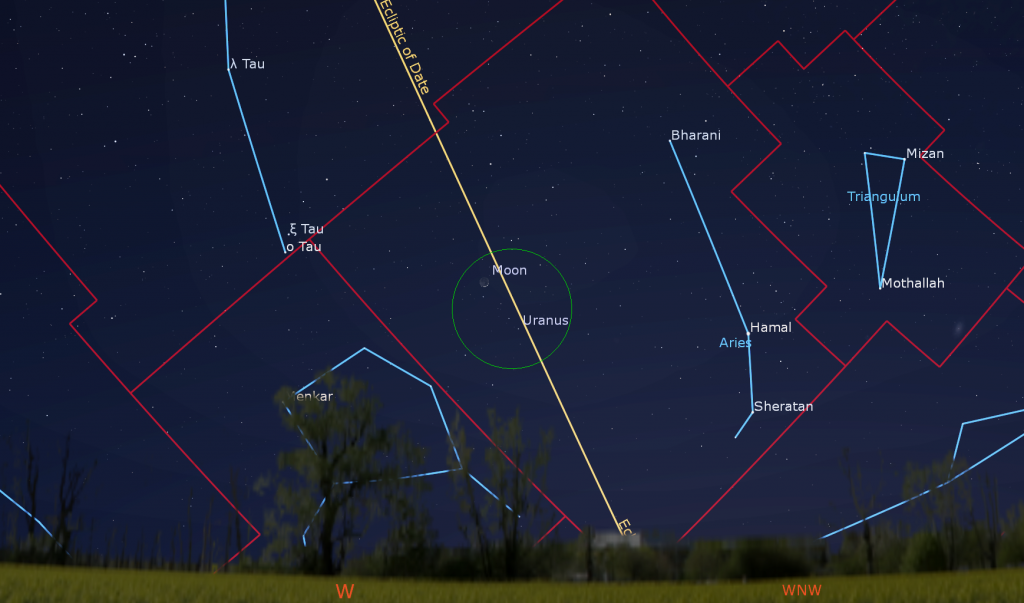
The Planets
Throughout April, four bright planets will be shining in the southeastern sky before sunrise. As I mentioned above, you can enjoy the crescent moon shining below Venus, Saturn, and Mars on Monday morning between about 6 am and dawn. Those three planets will remain in place on the subsequent mornings, while the moon slides away from them. They’ll rise a bit earlier each morning, allowing them to climb higher before the brightening sky hides them.
To start this week, Venus, Saturn, and Mars will form a sideways triangle in your binoculars. But Venus’ rapid sunward swing will stretch the trio into a line from Wednesday morning onward. Meanwhile, faster Mars will creep closer to slower-moving Saturn each morning, bringing them telescope-close next Monday-Tuesday! All three will shine among the stars of Capricornus (the Sea-Goat) until Venus passes into Aquarius (the Water-Bearer) next week.
In a telescope Venus will exhibit a half-illuminated, waxing gibbous phase, which even good binoculars can hint at. Any size of telescope will show you Saturn’s full globe and its rings, while Mars will show a tiny, 92%-illuminated disk. (Be sure to turn all optics away from the eastern horizon before the sun rises.)
The bright dot of Jupiter will continue to gradually break free of the sun’s glow this week. On Monday morning, it will rise around 6:35 am, about half an hour before the sun. On next Sunday morning, the king of planets will rise 20 minutes earlier. To help you locate it, Venus will be positioned several fist widths to Jupiter’s upper right (or about 27° to the celestial west). Observers located closer to the tropics will see Jupiter more easily.

Uranus is the only planet remaining in the evening sky, but decent telescope viewing opportunities are basically over with for this year. Once the sky becomes fully dark, towards 9 pm local time, use binoculars or a backyard telescope to look for the magnitude +5.8 planet shining a quarter of the way up the western sky. Its small, blue-green dot will be positioned a generous fist’s width to the left of (or 11 degrees to the celestial southeast of) Hamal, which is the brightest star in Aries (the Ram).
Leo Leads to Spring Galaxies
The bright moon’s departure from the evening sky worldwide this week will open galaxy-viewing season! That’s a roughly two month window when the Milky Way descends to the horizon, leaving the evening sky overhead free of its obscuring gas and dust, and letting us peer into the deep Universe at the other galaxies there! On the dates when the moon is close to the daytime sun or rises after midnight, we are treated to especially dark skies for hunting these faint, but majestic objects. This year, those blocks of time are this week and again from to April 23 to May 4. Plan your cottage and camping visits with that in mind!
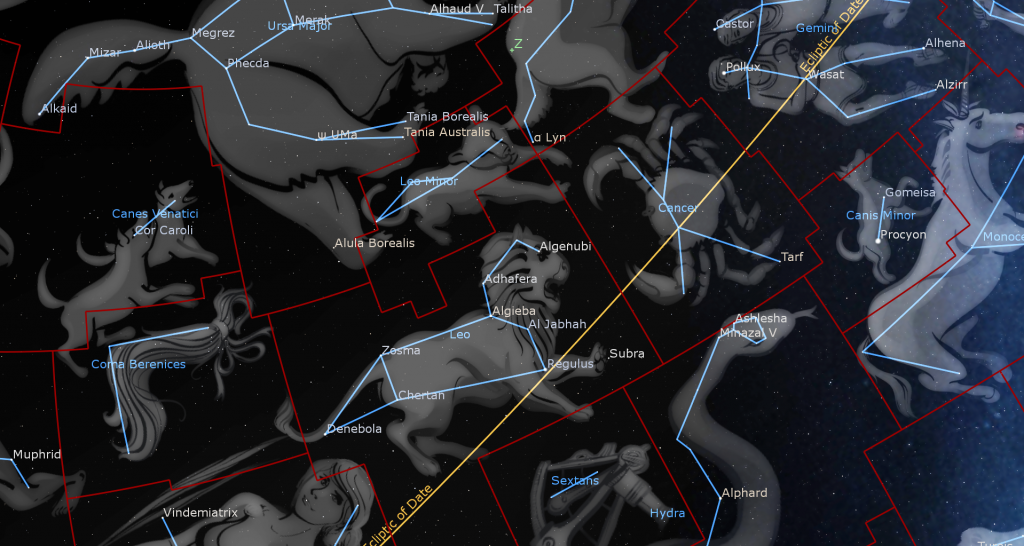
The best places to find galaxies are between the constellations of Leo (the Lion) and Virgo (the Maiden), and the constellations above them, Coma Berenices (Berenice’s Hair), Canes Venatici (the Hunting Dogs), and Ursa Major (the Big Bear). That’s because the spot on the celestial sphere that points directly out of our Milky Way galaxy’s disk, the North Galactic Pole, is located in Coma Berenices. To better acquaint you with the sky, let me introduce you to Leo, the Lion.
For millennia, sky-watchers have imagined the stars in the night sky linking into patterns – forming humans and animals and inanimate objects. We call these groupings constellations, after the Latin for “stars grouping together”. Each culture has assigned their own spin on the heavens, usually naming the patterns after things in their everyday experience. For example, south sea islanders saw outrigger canoes. The Inuit in the north saw the Big Dipper as the Caribou and Cassiopeia’s “W-shape” as the Blubber Container, with a Lamp Stand shining nearby.
In modern-day astronomy, the entire sky is divided into 88 officially recognized constellations. The manner in which the stars are connected into stick figures is not regulated, but the boundary lines between the constellations is. That way, there are no gaps in the coverage, and every object in the heavens can be placed within one of the 88 regions. By the way, astronomy has a long tradition in China – and they connected smaller groups of stars, yielding several hundred Chinese asterisms or 星官, xīngguān.
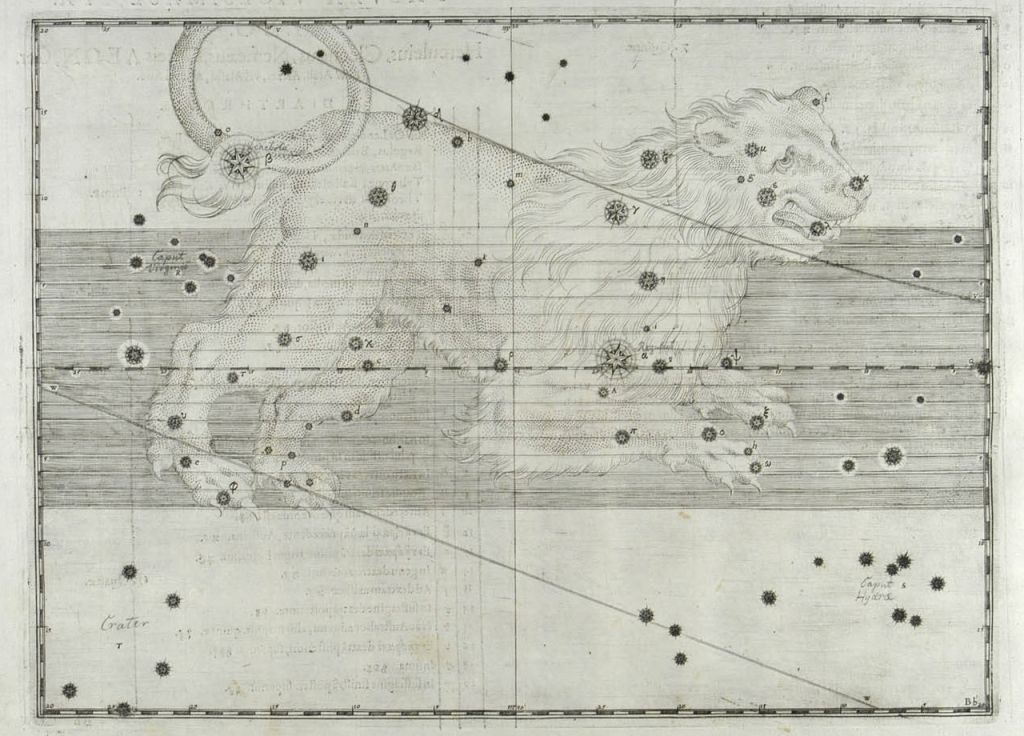
A handful of constellations are so obvious that many independent cultures assigned the same meaning to those stars. A perfect example of that is the spring constellation of Leo (the lion). The lion was identified as early as 1000 BCE by the Babylonians, and later by the Egyptians, Greeks, and Romans. To the Greeks it represented the Nemean Lion slain by Hercules during his labours. Only that beast’s own claws were sharp enough to slice its hide.
It’s easy to find and recognize Leo, even from suburban skies. Head out on the next clear evening and face the southeast. Leo is a large constellation situated halfway up the evening sky, and just above the imaginary ecliptic line that the Sun, Moon, and planets all travel close to. For this reason, Leo is one of the twelve Zodiac constellations. He is positioned with his head facing right (celestial west) and his tail towards the left (east). In some depictions, he has no legs or feet, as if he’s got them tucked underneath himself! Tilted tail downwards in early evening, the lion will level out in the southern sky around midnight, and then descend headfirst in the west until almost dawn.
The lion’s brightest star is Regulus (or Alpha Leonis). Regulus means “Little King” in Latin and its Arabic name Qalb Al Asad translates to “the heart of the Lion”. Regulus is a blue-white star with a small, nearby companion star that can be seen in binoculars. Regulus is the 21st brightest star in the heavens. Its position very close to the ecliptic allows it be occulted frequently by the moon and the inner planets. In a telescope, a tiny companion star will appear next to it.
From Regulus, look upwards and trace out another five modestly bright stars arranged in a backwards question mark with Regulus serving as the “dot”, or perhaps a sickle. It stands about 1.4 fist diameters tall. This represents the lion’s neck, head, and mane. The medium-bright, white star that sits a slim palm’s width above Regulus is Al Jabhah (or Eta Leonis). It emits up to 20,000 times more light than our own sun, but its distance of 1270 light-years makes it dim enough to shine near the limit of visibility for suburban stargazers.
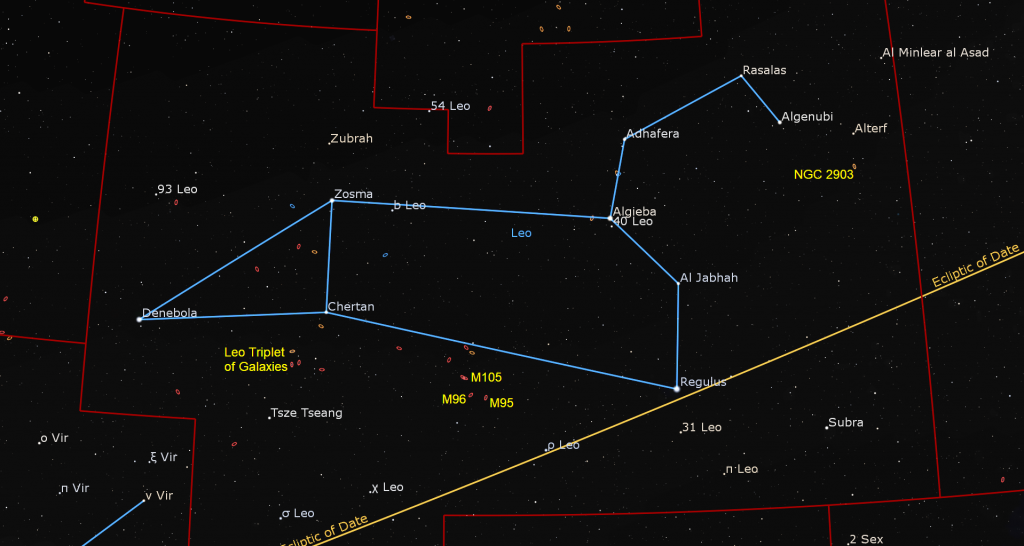
The second star up from Regulus shines several finger widths to the upper left (or 4° to the celestial northeast) of Al Jabhah. This is a brighter star named Algieba, or “the forehead”. In a backyard telescope, Algieba splits into a very pretty yellow and blue pair of stars, one slightly brighter than the other. A third star shines well-separated from the pair. The medium-bright, yellowish star positioned above Algieba is Adhafera (or Zeta Leonis), which comes from the Arabic aḍ-ḍafīrah “the braid/curl”, possibly a reference to its position in the lion’s mane. The star has two bright companion stars when viewed in a backyard telescope.
The next star, found with a larger hop toward Adhafera’s upper right, is Rasalas (or Mu Leonis), an abbreviation of Al Ras al Asad al Shamaliyy, which means “The Lion’s Head Toward the South”. Yellow-tinted Rasalas is only about 125 light-years away from us, and is known to be orbited by a giant planet. At the end of the sickle, a bit lower than Rasala, we find medium-bright, yellow star Algenubi (or Epsilon Leonis), which marks the beast’s nose. Both Algenubi and Ras Elased Australis mean “the Southern Star of the Lion’s Head”.
A fainter, reddish star named Alterf (or Lambda Leonis) shines just a few finger widths in front (west) of the lion’s nose. The name arises from the Arabic word Aṭ-ṭarf “the View (of the Lion)”. A very similar star named 31 Leonis shines a short distance below Regulus. And, and even redder star named Pi Leonis shines to finger widths below and to the right of 31 Leonis. Check them out in binoculars!
Let’s trace out the rest of the lion. Starting from Algieba, cast your gaze a generous fist’s width to the left (or 13° to the celestial east) to find a star of similar brightness named Zosma (or Delta Leonis). It represents the lion’s hip. Zosma is a hot, white star about twice the diameter of our sun – although its rapid spin (100 times faster than our sun’s) has given it an oblate form. We know so much about the star because it only 54 light-years away.
Angling down and to the left of Zosma by another fist’s width, we reach the star marking the lion’s tail, Denebola (or Beta Leonis), the second brightest star in the constellation. Denebola is a young, blue-white star only a few hundred million years old. It emits quite a bit of infrared radiation, suggesting that this young sun may have a planet-forming dust disk around it. It’s a mere 36 light-years away from us!
The last major star of Leo, named Chertan (or Theta Leonis), sits to the lower right of Zosma and Denebola, forming a nice triangle. The name Chertan is derived from the Arabic al-kharātān “Two Small Ribs”, which originally referred to the up-down line formed with Zosma.
Now that you see the lion – can you see the mouse? It’s easy to imagine the sickle of stars as a mouse’s curly tail, and Denebola and Zosma as the mouse’s nose and eye!
Leo is a favorite of amateur astronomers because it contains a nice selection of relatively nearby and bright galaxies – and Chertan is your guidepost to finding them!
A medium-bright star named Iota Leonis (or Tsze Tseang) shines to the lower left (or celestial south-southeast) of Chertan. (It’s the same distance from Chertan that Zosma is.) On a moonless night in a location away from city lights, aim your big binoculars or a backyard telescope halfway between Chertan and Iota. There, you should see a clump of three spiral galaxies known as the Leo Triplet. All three galaxies will share the eyepiece in a good telescope at low magnification. Two of the galaxies sit closer together. Those are numbers 65 and 66 on Charles Messier’s famous list of deep sky objects, so astronomers call them M65 and M66. A third, fainter galaxy sits a little bit apart. That’s the Hamburger Galaxy, or NGC 3628, so-named for its distinctive shape.
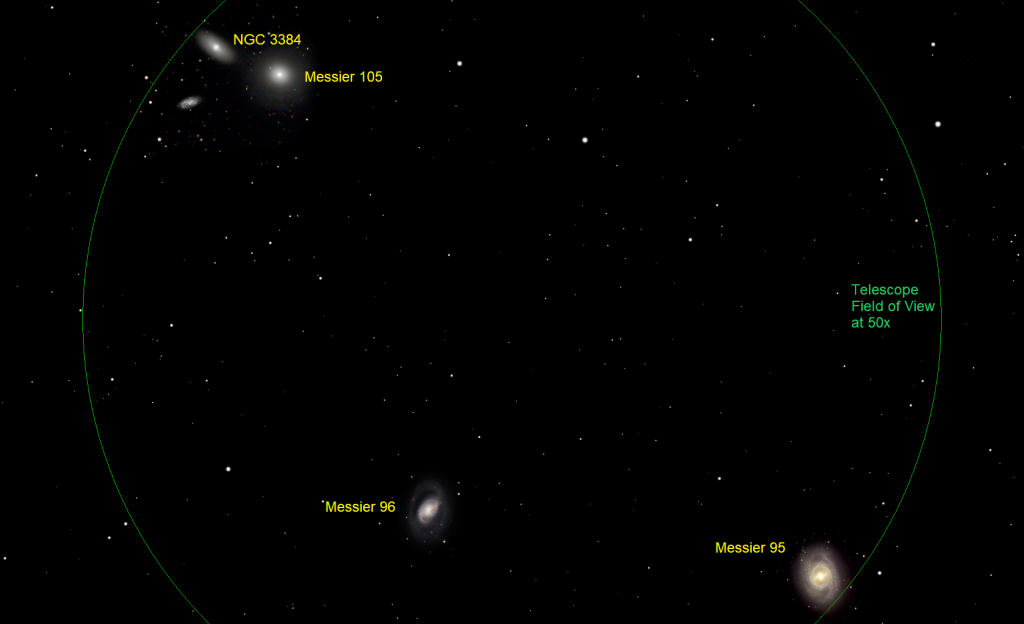
A second, more widely separated group of galaxies is located midway between Chertan and Regulus, and two finger widths below the line joining those two stars. Named the Leo I Group, it contains M95, M96, and M105 – plus another non-messier galaxy named NGC 3384.
And that’s just the beginning. A very nice and bright galaxy named NGC 2903 sits just a thumbs width below (or 1.4° to the celestial south of) the star Alterf. Moreover, the patch of sky located about a fist’s diameter to the rear of Denebola contains dozens of bright galaxies! But that’s another story…
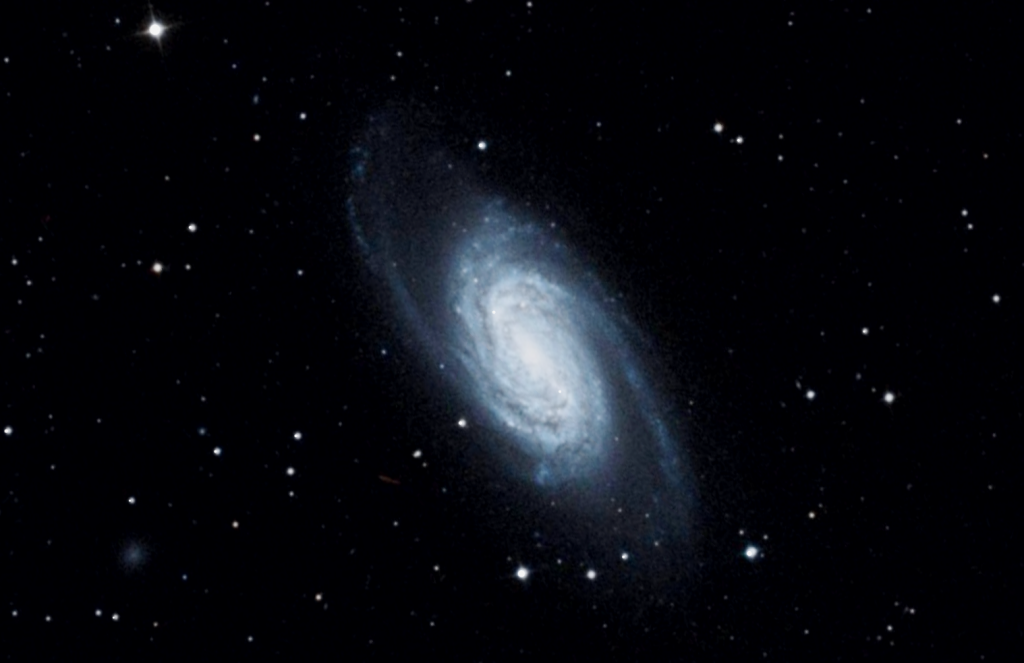
Gemini and Winter Treats for Dark Nights
If you missed last week’s tour and some gems to see in Gemini (The Twins) – with your unaided eyes, or in binoculars and telescopes, it’s here.
Public Astro-Themed Events
Every Monday evening, York University’s Allan I. Carswell Observatory runs an online star party – broadcasting views from four telescopes/cameras, answering viewer questions, and taking requests! Details are here. They host in-person viewing on the first clear Wednesday night each month. Other Wednesdays they stream views online via the observatory YouTube channel. Details are here.
My free, family-friendly Insider’s Guide to the Galaxy webcasts with Samantha Jewett of RASC National returns on Tuesday, March 29 at 3:30 pm EDT, when we’ll talk about springtime galaxies, take a guided tour through the Virgo Cluster of Galaxies, and explain how to see all 110 objects in Charles Messier’s list of spectacular deep sky objects in a single night as we continue with our Messier Objects observing certificate program. You can find more details and the schedule of future sessions here.
Don’t forget to take advantage of the astronomy-themed YouTube videos posted by RASC Toronto Centre and RASC Canada.
Keep looking up, and enjoy the sky when you do. I love questions and requests. Send me some!